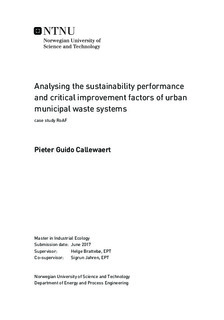Analysing the sustainability performance and critical improvement factors of urban municipal waste systems - case study RoAF
Master thesis
Permanent lenke
http://hdl.handle.net/11250/2454900Utgivelsesdato
2017Metadata
Vis full innførselSamlinger
Sammendrag
The shift towards a circular economy is a crucial factor to combat climate change and resource depletion. In this context, the European Union adopted the circular economy package resulting in different targets for the waste sector. One of these targets is a 65% recycling rate for municipal waste by 2030. Furthermore, a proposal for a 55% recycling target for plastic packaging was submitted in 2015. The literature study revealed a need for more system assessment tools to support decision making. Norway was identified as one of the countries that needs tools to rationalise their choices and to design effective strategies toward circularity.
A system assessment model was developed based on the principles of material flow analysis. The model was used to analyse the performance of the current waste management system of RoAF (Romerike Avfallsforedling) outside Oslo with respect to recycling, energy efficiency and emissions. RoAF is currently the only company that sends its residual waste through a central sorting facility, thereby separating plastic, metal and paper from residual waste. This practice is considered to help Norway reaching the circular economy targets and multiple sorting facilities are currently in the planning phase.
Improving organic collection was found to be the key factor leading to a higher recycling rate. Better organic collection will also increase the performance of the sorting facility which leads to more plastic recycling and secures a high climate benefit. To reach the municipal recycling target, it is necessary to improve the collection of all waste fractions. Implementing multiple sorting facilities is not enough to reach the 65% target, but is considered as an effective strategy to reach the 55% target. However, the benefits from a sorting facility are likely to be dependent on the performance of each waste management system.
